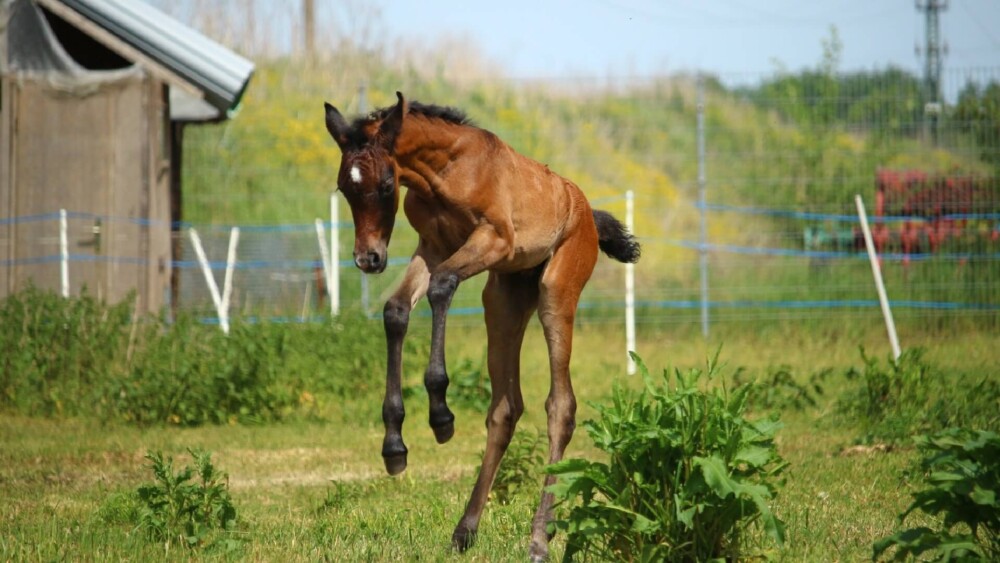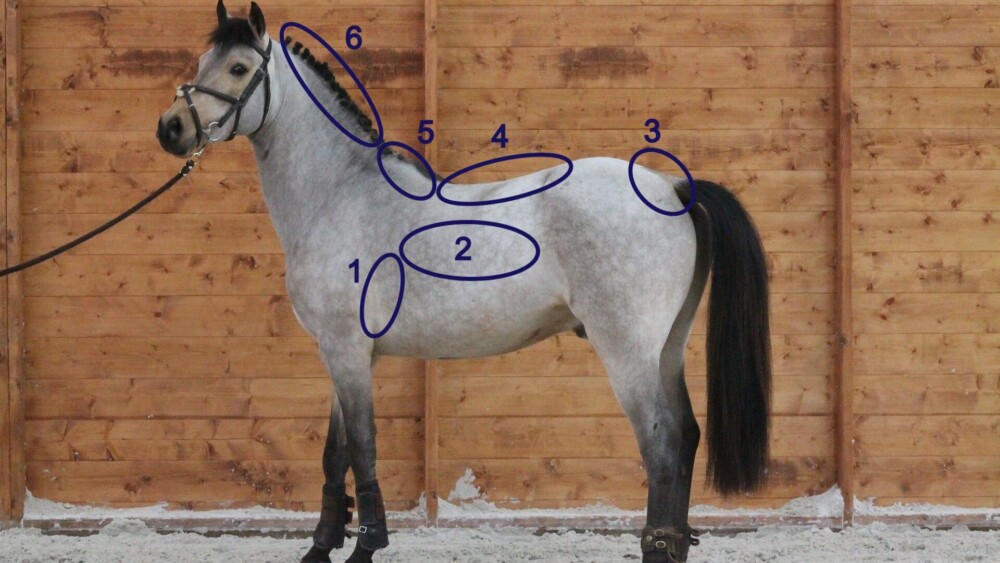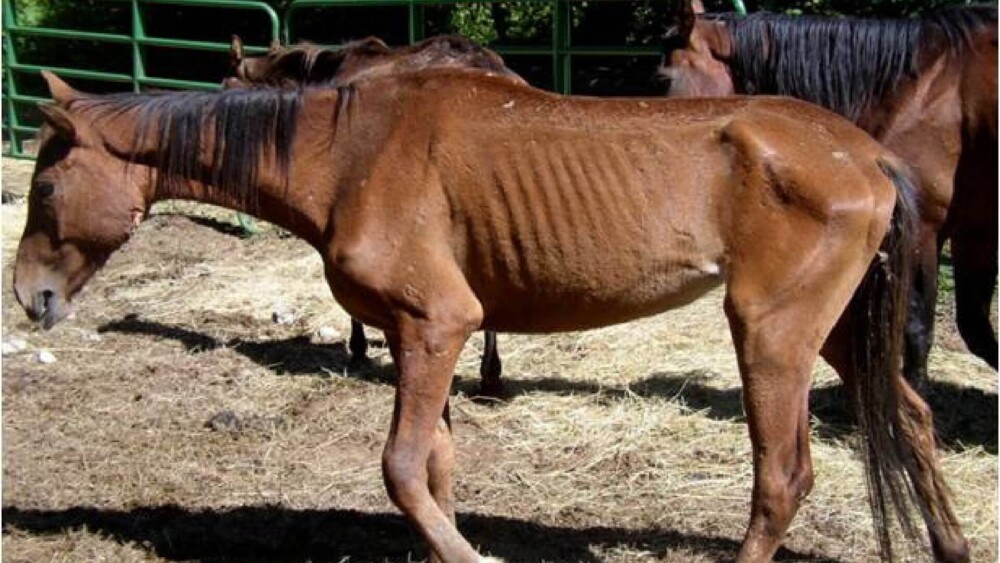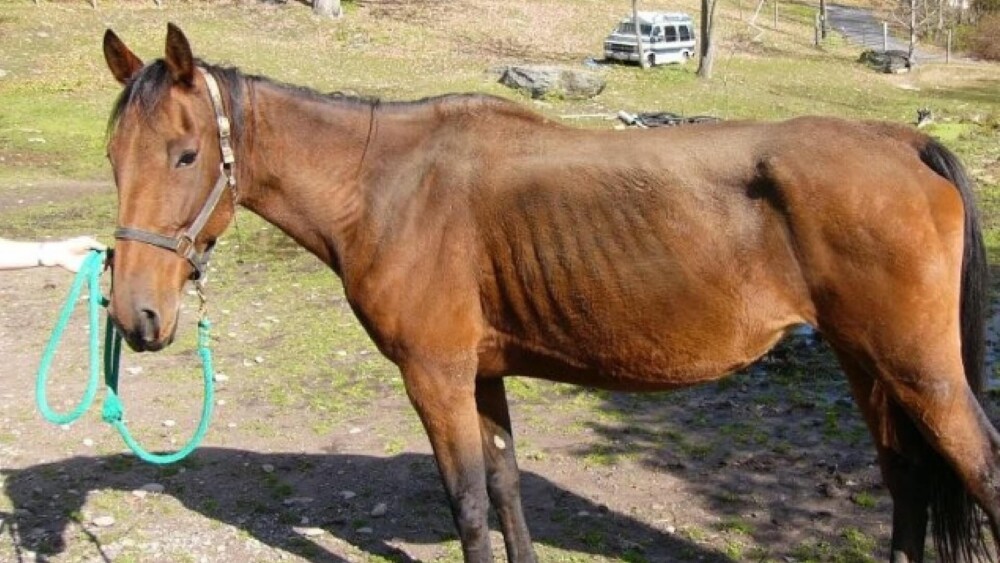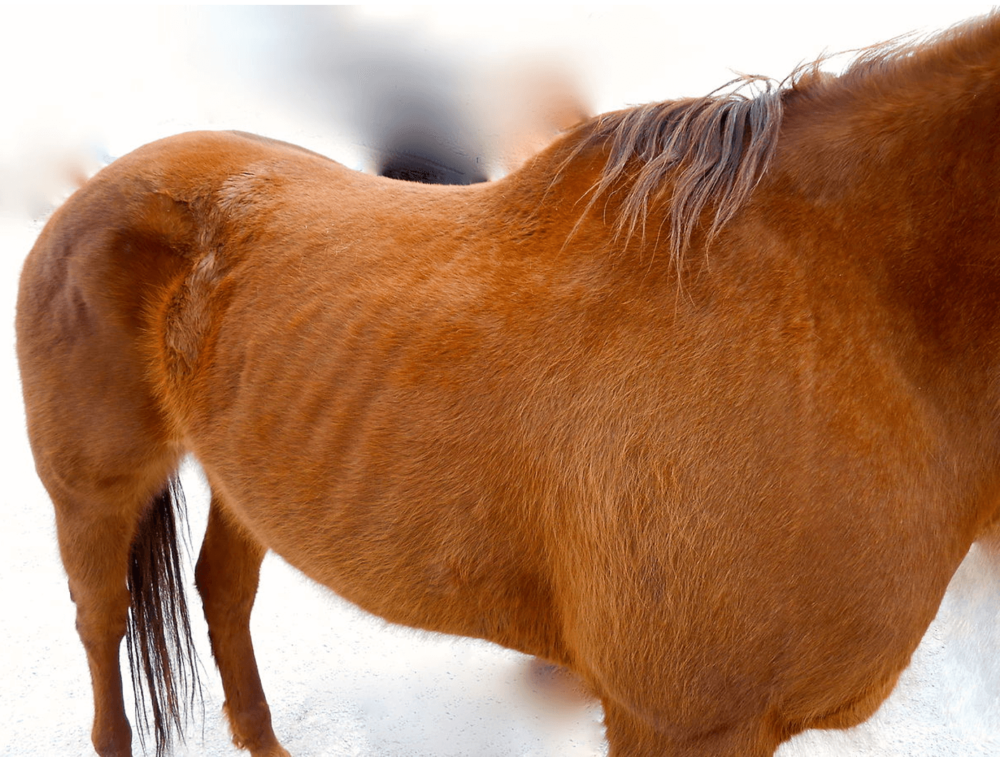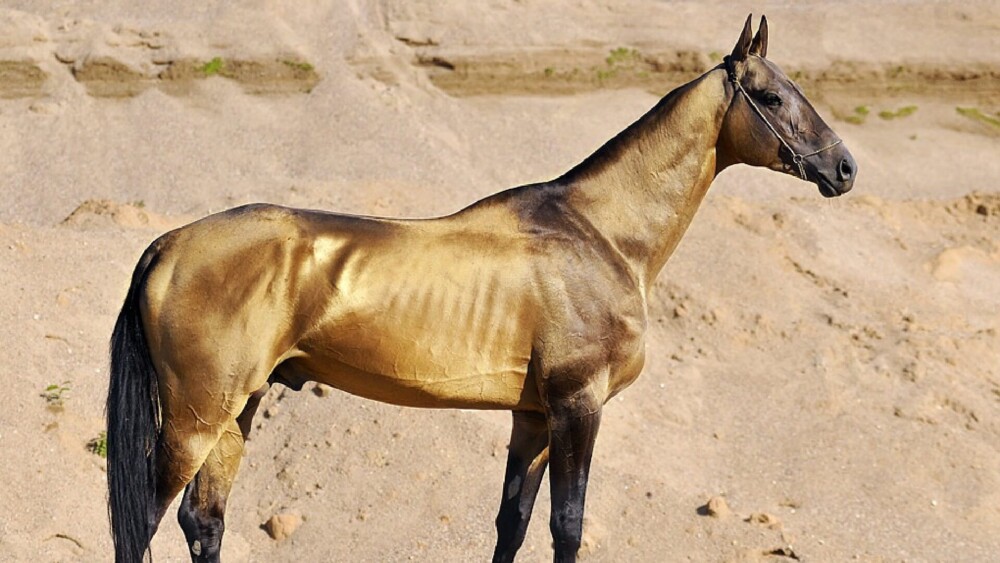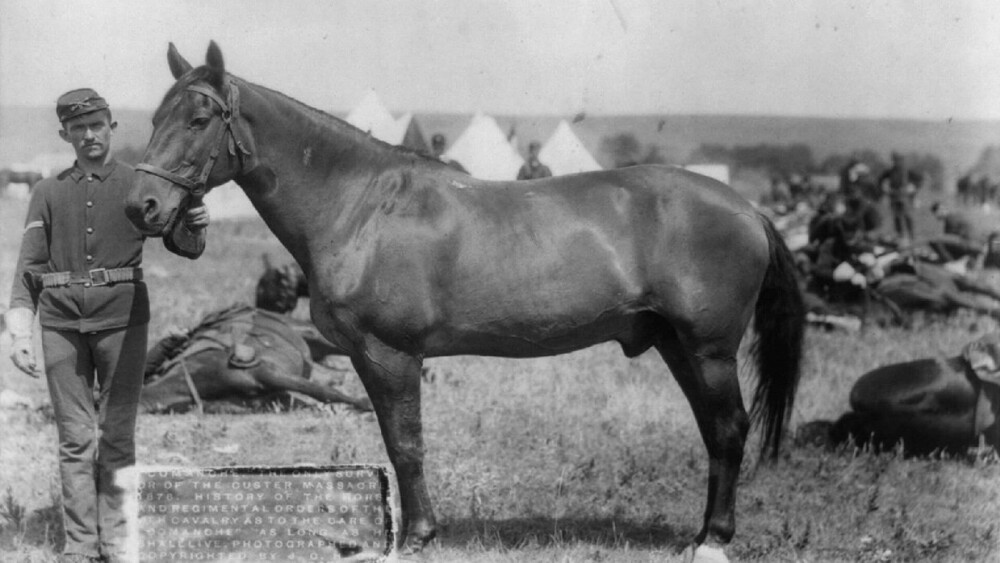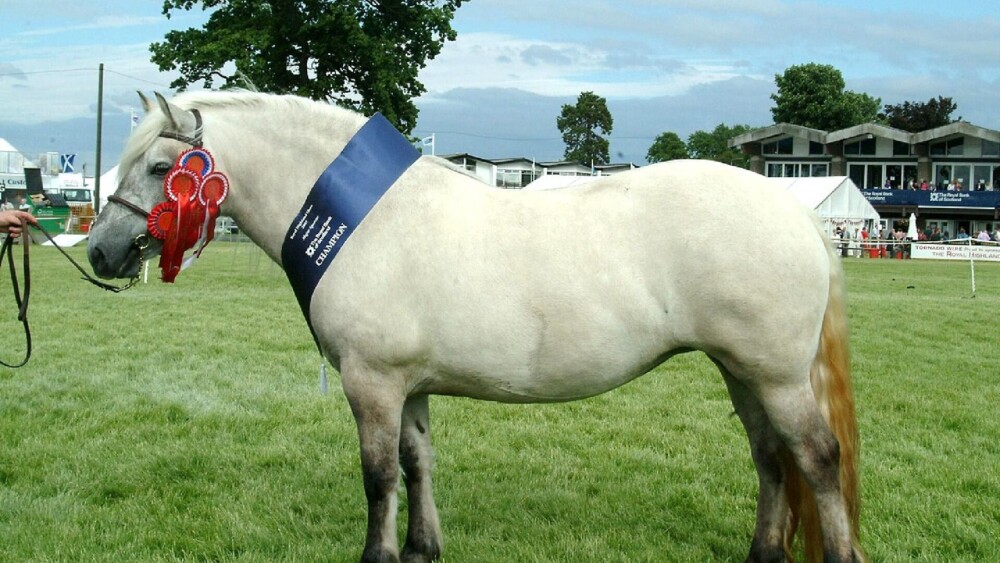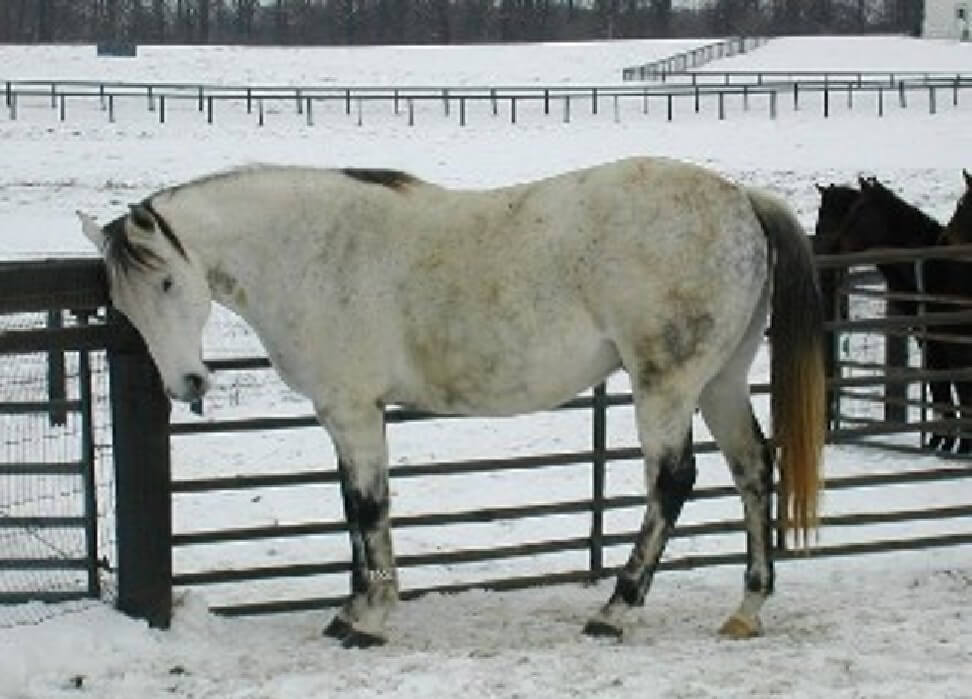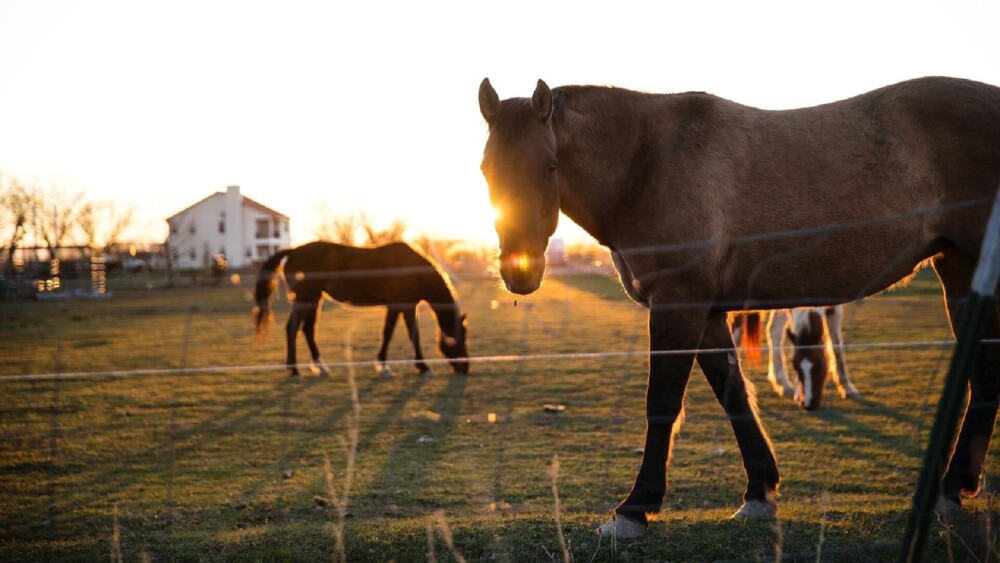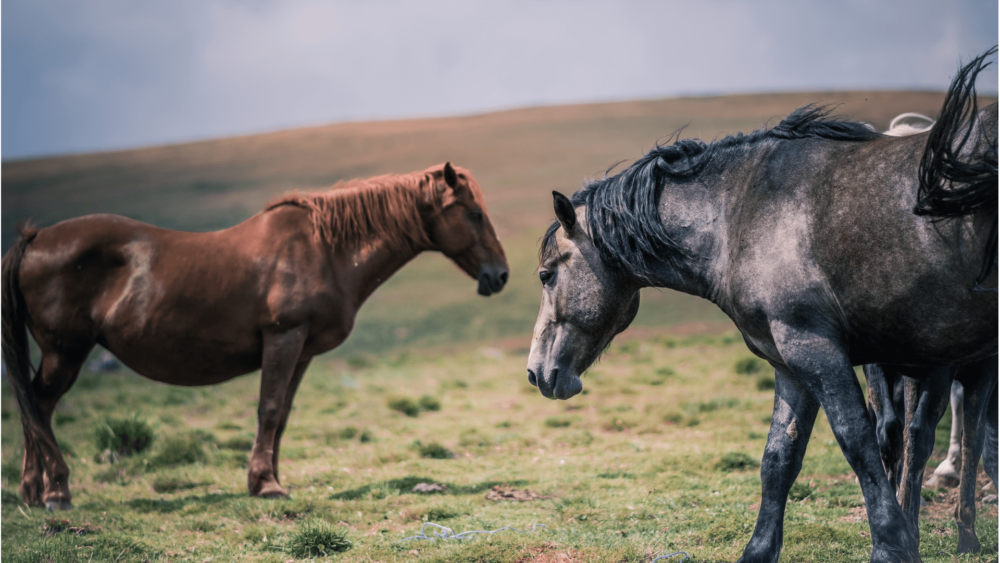An underweight horse lacks the energy to perform to its best ability. It may also experience pain when ridden and develop other health issues. Older horses are particularly prone to unhealthy weight loss.
As a horse ages his digestive tract changes. This makes it harder for the horse to process nutrients. It’s not only senior horses that battle with weight loss, however. Several factors lead to weight loss in younger horses.
How can you help a thin horse gain weight and muscle? A combination of high-quality concentrates, good pasture and hay, and constant access to freshwater will help your horse gain weight. Combine this balanced diet with plenty of turn-out time and exercise that’s appropriate to your horse’s fitness level to help him build and maintain his body condition.
Getting a horse to gain weight without becoming fizzy or hot can be a challenge, especially if they have retired from ridden work. Finding the right combination of nutrition and exercise is essential for both weight gain and body condition maintenance.
Before you can devise the right weight gain program for a horse, you need to assess its body condition, weight, and fitness levels. We also need to know what’s causing the horse to lose weight.
It’s a lot to manage, but I’m going to cover what you need to know.
9 Signs Your Horse is Underweight
Use a body condition scoring system to establish if your horse is underweight.
Body condition scoring (BCS) assesses how much fat the horse is carrying. By focusing on six key areas, you can establish your horse’s weight through a visual and hands-on assessment:
- Neck
- Withers
- Behind the shoulder
- Along the back
- Rib area
- Tail head
There are nine scores to rate a horse and its level of under or overweight. Let’s cover them.
#1 Emaciated Horse
A horse that’s emaciated will have a concave neck and back, with poor muscling along the top line that runs from the withers to the tail. His hips and ribs will stick out, and he’ll have very little flesh around the shoulders.
#2 Very Thin Horse
A very thin horse will have more flesh covering the spine, shoulder, and hindquarters, but his ribs will still be visible and his hips prominent. If you run your hand over a very thin horse, you’ll be able to feel each vertebra. The horse will also appear tucked up in front of the stifle joint and hollow through the quarters.
#3 Thin Horse
While a thin horse will have some fat covering its ribs, they will still be easily discernible. His top line will be concave and the tail head or dock prominent. While you can still feel individual vertebrae when conducting a hands-on assessment, they’ll no longer be visible. The point of the croup and the hip will also be pronounced.
#4 Moderately Thin Horse
The hips and tailhead remain easily discernible in a moderately thin horse but will be more rounded than in a thin horse. The neck, shoulders, and withers will be accentuated, but the individual vertebrae will no longer be as pronounced.
#5 Moderate Horse
A horse at a moderate weight is healthy. His shoulders and neck will blend smoothly into a level back while the fat deposits around the tailhead will begin to feel slightly spongy. The ribs will no longer be visually distinguishable, although they should be discernible to the touch.
#6 Moderately Fleshy Horse
As the fat starts to accumulate in the neck, a moderately fleshy horse develops the start of a crest. More fat deposits will also be visible around the shoulders and withers. The area around the tailhead will be soft and spongy. You may also notice your horse developed a slight groove along his topline.
#7 Fleshy Horse
With more fat covering the ribs, you can only feel them if you put pressure on a fleshy horse’s sides. You will also notice fat filling the spaces between the ribs and accumulating along the neck. The fat deposits behind the shoulders, and around the withers and tailhead will also be more discernible.
#8 Fat Horse
With a thickening neck and a distinctive crease along the back, a fat horse is easy to identify without a physical examination. The ribs will be difficult to feel and the shoulder flush with the body. The withers and tailhead will also be filled with fat.
#9 Extremely Fat Horse
An obese or extremely fat horse will have bulging fat deposits in all the key areas: neck, withers, shoulders, and tailhead. It will also have an obvious crease along the back and patchy fat covering the ribs. This level of obesity is dangerous, increasing stress on both the heart and lungs and increasing the horse’s risk of developing laminitis.
Three Methods For Weighing Your Horse
While a body condition scoring system will help you establish if your horse is too thin, it won’t give you a precise weight. If you want to know how much your horse weighs, you need either:
- A horse weighing scale or platform
- A weight tape
- A weight tape and horse weight calculator
Most horse owners use a weight tape to establish their horses’ weight. These are cheaper and much easier to store but aren’t as accurate as weighing platforms.
According to the responses on the one horse forum, some weight tapes may knock off as much as 30 kg or 60lbs, while others show weights far above those indicated by a weight platform.
Weight tapes are designed to measure the average horse. That means one that’s a standard size, shape, and body type. If your horse stands around 16hh and weighs approximately 1000lbs, a weight tape should be pretty accurate.
For young horses, ponies, and Warmblood or draft breeds, however, significant discrepancies may occur.
Using a horse weight calculator along with a weight tape will give you a more accurate reading, but a weighing platform is the most precise.
#1 Using a Weighing Platform
A weighing platform is a simple, although expensive, piece of equipment. Walk your horse onto the platform, and his weight will appear on a digital display.
#2 Using a Weight Tape
To get figure out if your horse is underweight using a weight tape:
- Stand your horse on a flat, even surface;
- Hold the end of the weight tape while sliding the tape over the horse’s back, just behind his withers;
- Take hold of the other end of the tape, drawing it around his girth area (also known as the heart girth);
- Make sure the tape is snug against the horse’s skin, bearing in mind that a thick winter coat can add a few pounds;
- Pull the ends of the tape together. The number displayed where the tape meets with the “zero” end is the amount your horse weighs.
#3 Using a Weight Tape and Calculator
Most horse weight calculators take the horse’s body length, as well as its heart girth, into consideration.
The best ones, such as this one, use four different measurements to provide a more accurate idea of your horse’s weight. These are:
- Height (at the withers)
- Body length (from point of the shoulder to the hip)
- Heart girth circumference (as explained above)
- Neck circumference (measured halfway between the poll and the withers with the neck in a relaxed position).
Enter these measurements into the calculator, and it will produce two results – your horse’s actual weight and its ideal weight. You can then adjust your horse’s feed intake and exercise regime with a clear goal in mind.
Not every horse will respond to a weight gain program, especially if there is an underlying issue causing his weight loss.
10 Common Causes of Equine Weight Loss
Horse owners will be familiar with some of the most common causes of weight loss, including:
#1 Stomach Ulcers
Research shows that gastric ulcers affect the majority of horses. One study focused on the prevalence of equine gastric ulcers syndrome (EGUS) in endurance horses during competition season. The results showed that EGUS affected 93% of the 30 horses studied. Check out our guide to horse ulcers: diagnosis, treatment, and prevention and understanding horse colic.
Weight loss is a common symptom of gastric ulcers. It may also be accompanied by one or more of the following symptoms:
- Lack of appetite
- Low energy
- Decreased performance
- Poor body condition
- Poor coat
- Change in attitude
- Unwillingness to train
If your horse is underweight and has any of the above symptoms, contact a vet immediately. A gastric endoscopy, or gastroscopy, will give a clinical diagnosis, after which your vet will recommend the appropriate treatment.
#2 Climate
Digestion creates body heat, especially when the body is processing fibrous materials like hay and grass.
As a result, it’s natural for horses to forage less during the hot summer months as digesting forage generates body heat (caring for horses in the summer). This can result in weight loss. You help prevent summertime weight loss by making sure your horse has access to shade and cool, clean water. A high-energy concentrate with a high-fat content will help boost your horse’s weight. The increased fat will also reduce his heat load.
When the cold winter weather arrives, horses need to use more energy to stay warm. A horse’s lower critical temperate (LCT) varies according to breed and the climate the horse is accustomed to, but the normal LCT is around 18 ℉.
A horse needs 1% more energy for each degree below its LCT. That means increasing his hay intake by around two pounds for each degree. This increase will give him an extra 1650 to 1800 calories to burn. For more information, find out how to care for horses in the winter.
#3 Liver problems
Liver disease is a relatively common problem in horses. It can be caused by:
- Toxins (in the form of poisonous plants, mycotoxins, or chemicals)
- Infections (such as Equine herpes virus, parasites, or Cholangiohepatitis)
- Inflammation (caused by gastrointestinal disease or chronic hepatitis)
Liver disease is difficult to treat, and the prognosis is often poor, although supportive therapy and treatments can have some positive effects.
My 18-year-old Arab mare developed liver problems after eating poisonous plants 10 years ago. A combination of milk thistle and a low-protein diet containing plenty of fruit and vegetables has enabled her to thrive. Her energy levels are still good, and she remains in moderate work.
#4 Heart problems
Even relatively minor heart murmurs can cause weight loss, as can more critical issues like heart disease. Dramatic weight loss or cardiac cachexia caused by the myocardial disease may even be fatal.
As well as losing weight, horses with heart failure commonly show the following symptoms:
- Breathing difficulties
- Abnormal gait
- Exercise intolerance
- Lethargy and tiredness
- Coughing
- Accumulation of fluids in the abdomen and legs
A vet will conduct an ultrasound, echocardiography, or echocardiogram to diagnose a heart problem. A horse with heart issues will be put on a treatment program to minimize damage to the heart muscle and alleviate associated symptoms.
#5 Anemia
There are several possible causes of anemia, including blood loss as a result of gastric ulcers. Pneumonia and abscesses can also cause anemia, as can anemia of inflammation. This latter condition occurs when the horse’s body holds onto its iron stores to inhibit the growth of bacteria.
Anemia can also be caused by:
- Equine infectious anemia
- Piroplasmosis
- Cancer
- Autoimmune disease
#6 Dental Issues
Dental problems are among the most common causes of weight loss in senior horses. As their teeth naturally wear away, older horses struggle to chew and process hay and grass.
A horse with badly worn teeth often takes longer to finish a meal than a younger horse who may push them away from pasture-fed food sources, exacerbating the problem.
Senior horses whose teeth lack enamel at the center may also drop “quids” or wads of moist hay instead of swallowing them. Regular dental check-ups combined with a diet of complete feed can help to combat weight loss caused by dental issues.
Check out Does My Horse Need to See a Dentist?
#7 Poor nutrition
A limited food supply is a common cause of weight loss in horses. If there is little grazing available, you need to supplement your horse’s diet with good-quality hay and grain.
Poor-quality hay or an unbalanced diet can also cause a horse to lose weight.
#8 Parasites
Many horse owners associate weight loss with a high worm count. This is a common misconception. Even a heavy parasitic load is unlikely to harm a healthy, well-maintained horse’s condition. Usually, other conditions need to also be present for worms to affect a horse’s weight.
Although every horse has some parasites, a high parasitic load makes it more difficult for your horse to absorb nutrients. It may also cause ulcers and hindgut inflammation, both of which can contribute to weight loss.
#9 Herd Hierarchy and Bullying
A horse that is constantly being bullied and pushed away from food sources by other, more dominant herd members will start to lose weight.
To combat this problem:
- Bring the horses in during feeding time
- Provide a separate feeding area for the thinner horses
- Spread out your feeding areas, leaving around 10 feet between each horse
- Separate the most dominant horse during feeding time
#10 Increased Exercise
Horses burn calories when they exercise so if you increase your horse’s workload, you need to boost his calorie intake accordingly.
A horse engaged in high-performance activities, like long-distance riding or hunting, needs greater quantities of grain and other concentrates to meet his nutritional requirements.
The Best Feeds for Weight Gain in Senior Horses
Older horses are more susceptible to weight loss as their teeth wear down and their digestive systems become less efficient.
Studies suggest that older horses benefit from commercial feeds created specifically for the senior horse. A pelleted feed containing 14% protein results in greater weight gain and faster improvements in body weight condition than a standard sweet feed mix.
According to veterinarians, the best senior horse feed is Purina Mill’s Equine Senior. A survey conducted by the American Association of Equine Practitioners showed that nearly 90% of veterinarians recommend this feed above all others.
A complete feed that helps senior horses gain weight needs to:
- Be easy to chew and digest
- Contain vitamins and minerals
- Include prebiotics to support the aging digestive system and produce an appropriate metabolic response to food
- Support gastric health
- Contain sources of fatty acids, such as vegetable oils, rice bran, or flaxseed.
If you can’t swap your horse’s grain product due to the rules at your livery yard, add a high-fat supplement to his daily ration instead. The best supplements for weight gain include:
- Rice bran
- Flaxseed
- Vegetable oil
- Beet pulp
To get a horse to gain weight, you also need to give him an adequate supply of high-quality forage. Rather than feeding grass hay, substitute a quarter of his daily ration with 25% alfalfa. Alfalfa has a higher protein content which will help your horse gain weight.
This richer diet is not without its problems, however. The additional protein may boost your horse’s energy levels to the point that he becomes fizzy or hot.
How to Feed Up a Horse Without Making it Hot
Exuberant behavior is dangerous even in a retired horse, and a food-related gallop around the field could end in injury. This hotness or exuberance is caused by foods with high sugar content. High starch feeds also cause unpredictable behavior and increased reactivity.
To increase weight without the associated high spirits, your horse needs a high-fiber diet. If you want to give him a safe energy boost, add a little vegetable oil to his daily ration.
A combination of beet pulp, grass pellets, and high-fiber mash is ideal for the older horse. It provides slow-release energy, is calorie-dense, and is easy to chew and digest.
The Nutritional Needs Of a Pregnant Mare
Pregnant mares are susceptible to weight loss, especially in the last three to four months of pregnancy. The mare’s nutritional needs increase in the last 90 days of her pregnancy when the fetus starts to grow and develop more quickly.
The larger the unborn foal, the more space it takes up in the mare’s body cavity. This means there’s less room for bulky forage and grass so, you can’t rely on this approach to meet your mare’s nutritional requirements. Instead, you need to supplement her diet with a high-quality concentrate.
Pregnant mares need more calories and more protein than other horses. These enable her to maintain her body weight and produce a healthy foal.
While high-quality alfalfa will help your pregnant mare gain weight, it’s not well digested in the upper gut. This means that many of the amino acids required for optimal foal development are lost.
As a pregnant mare has less room in her body cavity, large portions are difficult to digest. She’ll gain weight more effectively if you give her three or four smaller grain meals a day, with each one weighing no more than 2.8kg.
Fat supplements like rice bran and vegetable oil boost a pregnant mare’s energy intake without straining her digestive system. Combined with a high-fiber, high-fat concentrate, this will help a mare gain weight without over-elevating her carbohydrate intake.
A ration balancer and mineral lick will also help meet the nutritional requirements of both mare and foal.
Encouraging Weight Gain in Foals
A gradual approach to weight gain is the best for foals and weanlings. Excessive weight gain or an unbalanced diet increases the foal’s risk of developing metabolic bone disease.
Foals start to take an interest in solid foods at two to four weeks. Creep feeding while the foal is still suckling will help him to gain weight safely. It will also prepare him for the transition to solid food, making the weaning process less stressful.
Creep feeding also gives the foal access to nutrients that the mare’s milk can’t provide in adequate quantities. A high-quality grain feed for foals is high in fat and fiber and contains the following vitamins and trace minerals:
- Calcium
- Copper
- Iron
- Manganese
- Phosphorus
- Zinc
Concentrated feeds such as soybean or alfalfa meal are recommended as they contain more lysine, the amino acid responsible for growth and strong joints.
You can introduce grain feeds when the foal reaches four to eight weeks of age. Start slowly, giving your foal one pound of creep feed for each month of age.
You can increase this gradually until it’s ready to wean, at which point you should be giving your foal between 2 and 3% of its body weight in feed and forage every day.
Foals and weanlings should also have free access to high-quality forage that contains a mixture of grasses and legumes. Supplement this with a trace mineral block to compensate for any deficiencies.
Getting a Young Horse to Gain Weight
A healthy weanling or yearling should have a body condition score of five. Anything more than makes them more susceptible to developmental orthopedic disease. Anything less could impair their ability to build muscle, bone, and bulk.
Balance is key to maintaining a young horse’s weight. This requires a ground-up approach to the horse’s nutrition. Focus on meeting your growing horse’s nutrient requirements first, then add additional calories only if necessary.
Processed grains are better than whole grains for young horses who have yet to develop their adult teeth. Commercial foal and weanling feed also contains the minerals, vitamins, and amino acids a young horse needs to maintain healthy body weight and continue its development.
A ration balancer can help offset any nutritional deficiencies in the young horse’s forage and maintain ideal calcium to phosphorus ratio.
Monitor your yearling’s weight by measuring him with a weight tape every 2 to 4 weeks. You can then adjust his diet according to his growth rate while maintaining his body condition.
Boosting Weight Gain in the Competition Horse
Hard-working competition horses, especially endurance horses and hunters, burn a lot of calories and therefore need more supplementary feeding than a horse in light work.
A hard-working competition horse needs to eat between 1.5 to 2% of its body weight in forage per day.
Slow-release energy sources, in the form of vegetable oils and fiber, will help him gain weight without making him over-excitable or hot.
Your feed choice should meet your horse’s daily energy requirement, support his digestive health, and optimize his metabolism and performance.
Exercises to Maintain or Build Muscle in Senior Horses
Some senior horses manage incredible feats of endurance and athleticism. For most, however, a 2-mile cross-country course or 40-mile endurance ride is too much. They do need some exercise to keep their joints moving and maintain muscle, but it needs to be appropriate to their abilities and fitness levels.
Plenty of turn-out time is the best exercise for a retired horse and helps him stay mobile while giving him a natural diet. This will also help them gain weight, assuming the grazing is good.
Taking your horse out walking in-hand or ponying him from another horse will also help to keep him mobile, maintain a healthy top line, and provide some mental stimulation.
You could also incorporate long-lining and simple groundwork exercises into his weekly routine.
Maintaining Muscle in a Pregnant Mare
Many horse owners stop exercising their mares as soon as they conceive for fear of endangering the fetus. Research shows, however, that pregnant mares benefit from limited moderate exercise and that this has no negative impact on their unborn foals.
According to the American Association of Equine Practitioners, it’s safe to ride a pregnant mare for the first seven months of her pregnancy.
Some experts, like Aime Johnson, an associate professor of theriogenology at Auburn University College of Veterinary Medicine, prefer to see the mare rest during the first 30 days.
“Those first 30 days are really critical,” Aime says, recommending that you avoid doing any high-level exercise with your mare until the pregnancy is more established.
If you don’t feel comfortable riding your pregnant mare, you could use some of the exercises recommended for senior horses instead. Some gentle lunging will also help her maintain healthy body and muscle functions.
As your mare enters her last trimester, she requires only light to moderate exercise. Plenty of turn-out time and some in-hand walking will help keep her in tip-top condition without causing her, or her foal, any discomfort or strain.
The Best Exercises for Conditioning the Young Horse
A horse that’s too young to ride will still benefit from some exercise. Even in foals, the right exercise will help the musculoskeletal system to develop while limiting muscle growth. Too much muscle mass on an immature body can cause deformities and other issues, such as arthritis.
The only exercise foals need is regular turn-out time with their mothers. Start with an hour of turn-out per day when the foal is a day or two old, increasing it gradually until, at 2 to 3 weeks, he’s spending a full day out in the field.
As horses grow, so they can cope with and benefit from, a more intensive exercise regime. Exercises for yearlings, colts, and fillies should focus on developing muscles, promoting optimal bone growth, and strengthening their tendons.
Groundwork exercises will prepare your young horse mentally and physically for ridden work later down the line. Start with basic halter training, walking him in hand to gently develop his muscles and expose him to new sights, smells, and sounds. Move onto in-hand pole exercises to develop muscle and flexibility.
As your horse develops new skills and more muscle, you can introduce gentle lunging and long-reining exercises. These will also improve balance and set your horse up for success later in life.
Conclusion
Any horse will lose weight if it lacks the appropriate level of nutrition.
A high-protein diet and 24/7 access to good forage will help an underweight horse gain weight, provided no underlying condition or illness is causing the weight loss.
Exercise also helps to improve your horse’s body condition by developing muscle and strengthening bones and tendons.
My Favorite Equine Resources For Horses and Donkeys
This list contains affiliate products. Affiliate products do not cost more but helps to support BestFarmAnimals and our goal to provide farm animal owners with accurate and helpful information.
Squeaky Chicken Toy is hilarious to watch and the horses love it! It’s not super tough so keep it away from dogs.
Dewormer with Ivermectin: I use this for my horses and my goats. Duvet makes a great dewormer. I switch between the Ivermectin one and one like this one so the worms don’t get immune to it.
Manna Pro Apple Flavored Nuggets are a delicious smelling treat that my horses go crazy over.
Equinity Amino Acid Supplement for Horses makes a big difference for any horse that’s struggling with arthritis, hoof issues, or just generally. It’s great for older horses who can’t absorb all the nutrients in their food as well!
Manna Pro Weight Accelerator helps older horses gain weight and stay healthier! This was especially helpful when one of my older horses lost weight over the winter and helped her regain her weight over the summer!
Farnam Fly Control goes on the horse or donkey and will keep the flies off your sweet pet. It makes horses way more comfortable and will keep sores from getting infected as well.
Wound Kote protects sores and wounds. It acts as an antiseptic and helps wounds heal faster. It works on both my horses and goats.

